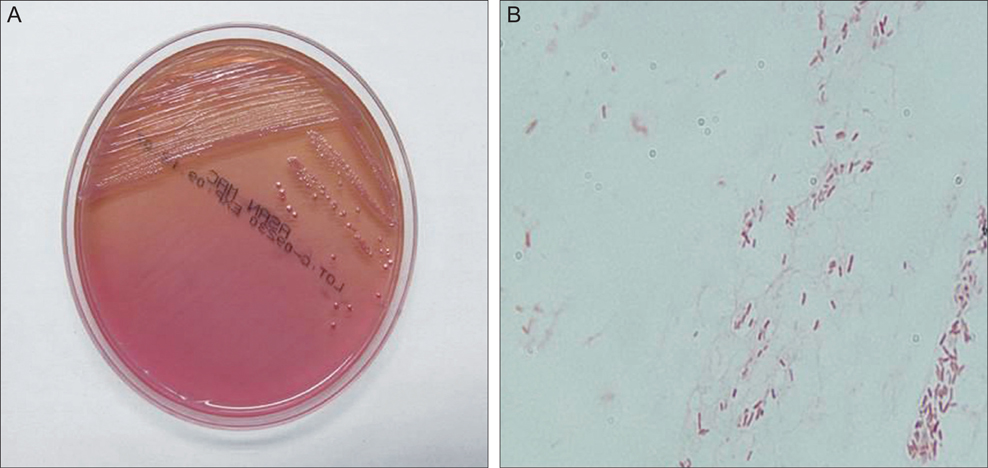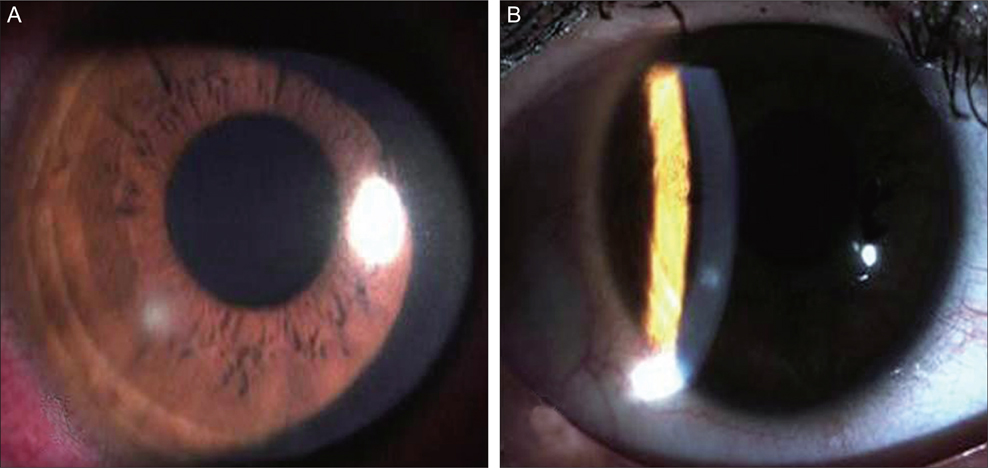Korean J Ophthalmol.
2012 Feb;26(1):49-53. 10.3341/kjo.2012.26.1.49.
Achromobacter xylosoxidans Keratitis after Contact Lens Usage
- Affiliations
-
- 1Department of Ophthalmology, Chosun University College of Medicine, Gwangju, Korea. clearcornea@paran.com
- KMID: 1120182
- DOI: http://doi.org/10.3341/kjo.2012.26.1.49
Abstract
- To report on Achromobacter xylosoxidans keratitis in two healthy patients who had worn contact lenses foran extended period of time. A 36-year-old female and a 21-year-old female visited our hospital with ocular pain and blurred vision. Both patients had a history of wearing soft contact lenses for over fve years with occasional overnight wear. At the initial presentation, a slit lamp examination revealed corneal stromal infiltrations and epithelial defects with peripheral neovascularization in both patients. Microbiological examinations were performed from samples of corneal scrapings, contact lenses, contact lens cases, and solution. The culture resulting from the samples taken from the contact lenses, contact lens cases, and solution were all positive for Achromobacter xylosoxidans. Confrming that the direct cause of the keratitis was the contact lenses, the frst patient was prescribed ceftazidime and amikacin drops sensitive to Achromobacter xylosoxidans. The second patient was treated with 0.3% gatifoxacin and fortifed tobramycin drops. After treatment, the corneal epithelial defects were completely healed, and subepithelial corneal opacity was observed. Two cases of Achromobacter xylosoxidans keratitis were reported in healthy young females who wore soft contact lenses. Achromobacter xylosoxidans should be considered a rare but potentially harmful pathogen for lens-induced keratitis in healthy hosts.
MeSH Terms
-
Achromobacter denitrificans/*isolation & purification
Adult
Amikacin/administration & dosage
Anti-Bacterial Agents/*administration & dosage
Ceftazidime/administration & dosage
Contact Lenses, Extended-Wear/*adverse effects
Female
Fluoroquinolones/administration & dosage
Gram-Negative Bacterial Infections/diagnosis/*drug therapy/*microbiology
Humans
Keratitis/diagnosis/*drug therapy/*microbiology
Tobramycin/administration & dosage
Figure
Reference
-
1. Mandell WF, Garvey GJ, Neu HC. Achromobacter xylosoxidans bacteremia. Rev Infect Dis. 1987. 9:1001–1005.2. Spengler RF, Greenough WB 3d, Stolley PD. A descriptive study of nosocomial bacteremias at The Johns Hopkins Hospital, 1968-1974. Johns Hopkins Med J. 1978. 142:77–84.3. Pien FD, Higa HY. Achromobacter xylosoxidans isolates in Hawaii. J Clin Microbiol. 1978. 7:239–241.4. Reverdy ME, Freney J, Fleurette J, et al. Nosocomial colonization and infection by Achromobacter xylosoxidans. J Clin Microbiol. 1984. 19:140–143.5. Shigeta S, Yasunaga Y, Honzumi K, et al. Cerebral ventriculitis associated with Achromobacter xylosoxidans. J Clin Pathol. 1978. 31:156–161.6. Yabuuchi E, Oyama A. Achromobacter xylosoxidans n. sp. from human ear discharge. Jpn J Microbiol. 1971. 15:477–481.7. Aisenberg G, Rolston KV, Safdar A. Bacteremia caused by Achromobacter and Alcaligenes species in 46 patients with cancer (1989-2003). Cancer. 2004. 101:2134–2140.8. Gomez-Cerezo J, Suarez I, Rios JJ, et al. Achromobacter xylosoxidans bacteremia: a 10-year analysis of 54 cases. Eur J Clin Microbiol Infect Dis. 2003. 22:360–363.9. Kish MA, Buggy BP, Forbes BA. Bacteremia caused by Achromobacter species in an immunocompromised host. J Clin Microbiol. 1984. 19:947–948.10. Knippschild M, Schmid EN, Uppenkamp M, et al. Infection by Alcaligenes xylosoxidans subsp. xylosoxidans in neutropenic patients. Oncology. 1996. 53:258–262.11. Legrand C, Anaissie E. Bacteremia due to Achromobacter xylosoxidans in patients with cancer. Clin Infect Dis. 1992. 14:479–484.12. Mizunoe S, Yamasaki T, Hirai K, et al. Case report: subcutaneous abscess and thoracic empyema caused by Alcaligenes xylosoxidans. Kansenshogaku Zasshi. 1998. 72:631–634.13. Shie SS, Huang CT, Leu HS. Characteristics of Achromobacter xylosoxidans bacteremia in northern Taiwan. J Microbiol Immunol Infect. 2005. 38:277–282.14. Tsay RW, Lin LC, Chiou CS, et al. Alcaligenes xylosoxidans bacteremia: clinical features and microbiological characteristics of isolates. J Microbiol Immunol Infect. 2005. 38:194–199.15. Weitkamp JH, Tang YW, Haas DW, et al. Recurrent Achromobacter xylosoxidans bacteremia associated with persistent lymph node infection in a patient with hyper-immunoglobulin M syndrome. Clin Infect Dis. 2000. 31:1183–1187.16. Reddy AK, Garg P, Shah V, Gopinathan U. Clinical, microbiological profile and treatment outcome of ocular infections caused by Achromobacter xylosoxidans. Cornea. 2009. 28:1100–1103.17. Slusher MM, Myrvik QN, Lewis JC, Gristina AG. Extended-wear lenses, biofilm, and bacterial adhesion. Arch Ophthalmol. 1987. 105:110–115.18. Bruce AS, Brennan NA. Corneal pathophysiology with contact lens wear. Surv Ophthalmol. 1990. 35:25–58.19. Newman PE, Hider P, Waring GO 3rd, et al. Corneal ulcer due to Achromobacter xylosoxidans. Br J Ophthalmol. 1984. 68:472–474.20. Huang ZL, Chen YF, Chang SW, et al. Recurrent Alcaligenes xylosoxidans keratitis. Cornea. 2005. 24:489–490.21. Fiscella R, Noth J. Achromobacter xylosoxidans corneal ulcer in a therapeutic soft contact lens wearer. Cornea. 1989. 8:267–269.22. Srinivasan S, McAllum P, Poutanen SM, Slomovic AR. Bilateral simultaneous Achromobacter xylosoxidans keratitis following penetrating keratoplasty. J Cataract Refract Surg. 2006. 32:2149–2152.23. Pan TH, Heidemann DG, Dunn SP, et al. Delayed onset and recurrent Alcaligenes xylosoxidans keratitis. Cornea. 2000. 19:243–245.24. Linke SJ, Skevas C, Richard G, Katz T. Bilateral Achromobacter xylosoxidans keratitis after laser in situ keratomileusis. J Cataract Refract Surg. 2010. 36:1045–1047.
- Full Text Links
- Actions
-
Cited
- CITED
-
- Close
- Share
- Similar articles
-
- A Case of Alcaligenes xylosoxidans Keratitis in a Soft Contact Lens Wearer
- A Case of Achromobacter Xylosoxidans Keratitis
- A case of scalp abscess caused by Achromobacter xylosoxidans after vacuum delivery
- Pseudomonas Keratitis Due to Mishandling of Soft Contact lenses
- Proper Management for Rigid Gas Permeable Contact and Orthokeratology Lens




